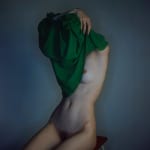




Richard Learoyd
Green, 2019
Unique ilfochrome photograph
114 x 95 cm (unframed)
140 x 120 cm (framed)
140 x 120 cm (framed)
Copyright The Artist
Further images
Richard Learoyd is best known for large-scale colour and black and white portrait, landscape, and still-life photographs, celebrated for their balance of hyper-real and expressive qualities. Learoyd produces his images...
Richard Learoyd is best known for large-scale colour and black and white portrait, landscape, and still-life photographs, celebrated for their balance of hyper-real and expressive qualities. Learoyd produces his images with the use of one of the most antiquarian of photographic processes: the camera obscura.
His in-studio custom-built camera contains two room-like chambers connected by a bellows with an inset lens. Working with ilfochrome colour-reversal paper, Learoyd uses the camera obscura to render a single positive, unique image with minute detail without film negatives or digital technology. The result is an entirely grainless image. The overall sense of these larger-than-life images redefines the photographic illusion. Learoyd’s subjects, composed simply and directly, are described with the thinnest plane of focus, re-creating and exaggerating the way that the human eye perceives, and not without a small acknowledgement to Dutch Master painting. The negatives are up to 80 inches wide, resulting in the largest gelatin-silver contact prints ever made.
Learoyd’s work is included in the collections of The Getty, Tate, Victoria & Albert Museum, Centre Pompidou, The Metropolitan Museum of Art, San Francisco Museum of Modern Art, Nelson-Atkins Museum, National Gallery of Canada, and Yale University Art Gallery, among others.
His in-studio custom-built camera contains two room-like chambers connected by a bellows with an inset lens. Working with ilfochrome colour-reversal paper, Learoyd uses the camera obscura to render a single positive, unique image with minute detail without film negatives or digital technology. The result is an entirely grainless image. The overall sense of these larger-than-life images redefines the photographic illusion. Learoyd’s subjects, composed simply and directly, are described with the thinnest plane of focus, re-creating and exaggerating the way that the human eye perceives, and not without a small acknowledgement to Dutch Master painting. The negatives are up to 80 inches wide, resulting in the largest gelatin-silver contact prints ever made.
Learoyd’s work is included in the collections of The Getty, Tate, Victoria & Albert Museum, Centre Pompidou, The Metropolitan Museum of Art, San Francisco Museum of Modern Art, Nelson-Atkins Museum, National Gallery of Canada, and Yale University Art Gallery, among others.











